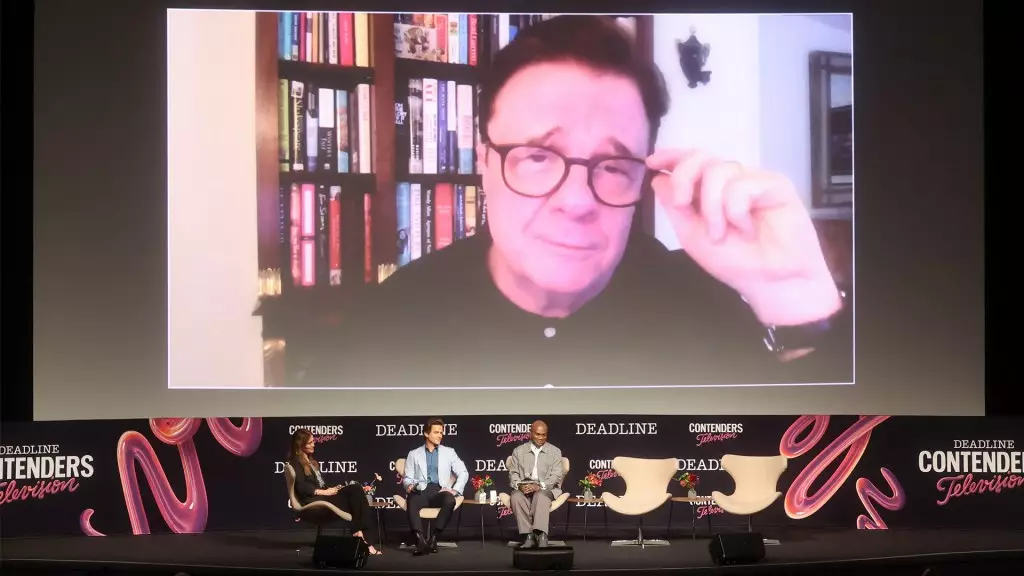In a world where political discourse often veers into hostile territory for marginalized communities, the emergence of LGBTQ+ narratives in mainstream media is not just timely; it’s essential. The latest multi-camera sitcom, *Mid-Century Modern*, starring Nathan Lane, Matt Bomer, and Nathan Lee Graham, serves as a refreshing counter-narrative to the prevalent negative sentiments surrounding LGBTQ+ identities. This show highlights the growing need for visibility, humor, and understanding within the LGBTQ+ community, particularly in an era where rights are under severe scrutiny.
Lane, Bomer, and Graham collectively emphasize the stunning relevance of their show during a panel discussion hosted by Deadline at the Contenders TV event. Without explicitly identifying the antagonists of their struggle, they articulate a sense of urgency for authentic representation, especially in a time marked by rising authoritarianism. Lane’s assertion, that their sitcom acts as a “weapon of joy,” resonates deeply; it reflects a desire for inclusivity and acceptance in a world that might seek to suppress it.
Life, Love, and Loss in Palm Springs
What makes *Mid-Century Modern* particularly captivating is its exploration of intergenerational relationships among its main characters, who comprise an eclectic group of aging gay men finding solace and companionship in Palm Springs after the death of a close friend. Each character embodies different facets of the LGBTQ+ experience, presenting a spectrum of emotional depth and comedic brilliance. Lane’s character, Bunny—a bra store mogul with a flair for drama—stands in stark contrast to the more subdued and contemplative Arthur (Graham) and the vibrant, effervescent Jerry (Bomer).
The contrast and camaraderie among these characters strive to provide insight into the lives of older gay men, often overlooked in entertainment narratives. Their sitcom dynamic captures the quintessential essence of a “found family”—an idea that resonates strongly within the LGBTQ+ community. The bursts of laughter peppered with poignant life lessons give the show an emotional honesty that feels both liberating and empowering.
A Seminal Role and Heartfelt Goodbye
Compounding the show’s warm-hearted narratives is the bittersweet reality surrounding the late Linda Lavin’s involvement. Lavin, who played Bunny’s mother, Sybil, left an indelible mark on the series and her sudden passing during filming marked a profound moment for the production team and cast alike. The creators, Max Mutchnick and David Kohan, faced a tremendous challenge in navigating the grief and loss as they strived to honor Lavin’s legacy while maintaining the comedic integrity of the show.
Episode 9, titled “Here’s to You, Mrs. Schneiderman,” addresses themes of loss and healing in a manner that balances humor and pathos. The episode stands as a testament to both Lavin’s remarkable career and the lasting impact she had on her co-stars. The vocabulary of love and remembrance wrapped within the fabric of laughter creates a remarkable tribute to a woman cherished both on and off-screen.
Addressing Misconceptions and Enhancing Authenticity
Despite the show’s positive reception, there have been misconceptions surrounding its production, particularly regarding the use of canned laughter. Graham’s spirited defense clarifies that the laughter heard during episodes stems from a genuine live audience rather than pre-recorded tracks. This emphasis on authenticity is crucial; it mirrors the reality of shared joy where LGBTQ+ narratives do not merely exist in a vacuum but are celebrated in communal spaces.
Moreover, this live element adds to the vibrancy of *Mid-Century Modern*, showcasing how laughter can act as a collective balm in the face of societal challenges. The actors’ commitment to delivering a narrative rich in warmth and authenticity is emblematic of the broader journey toward equality, acceptance, and joy within the LGBTQ+ community.
As narratives like *Mid-Century Modern* continue to emerge, the entertainment landscape becomes a richer tapestry of voices, experiences, and representations. It fosters not only visibility for LGBTQ+ individuals but also allies in the fight against prejudice and inequality, illustrating how joy and resilience can thrive even amid adversity.
